 |
 |
AbstractBranchio-oto-renal (BOR) Syndrome is a rare autosomal dominant genetic disorder characterized by features such as branchial arch anomalies, hearing loss, preauricular fistula, auricular malformations, and renal abnormalities. Also, BOR syndrome without renal anomalies is referred to as branchio-otic syndrome. In this report, we present a case of a 50-year-old female patient with bilateral type 2 branchial arch anomalies, both preauricular fistula, bilateral inner ear malformations, bilateral sensorineural hearing loss, and right auricular malformation. The patient underwent surgical treatment. This report is the first documentation in Korea of auricular malformation in BOR syndrome, where the patientŌĆÖs family exhibited a typical autosomal dominant inheritance pattern.
ņä£ ļĪĀņāłņŚ┤ņØ┤ ņ”ØĒøäĻĄ░ņØĆ ņāłņŚ┤ĻĖ░ĒśĢ, ļé£ņ▓Ł, ņŗĀņן ņØ┤ņāü ņåīĻ▓¼ ļō▒ņØ┤ ņ×äņāüņĀü ĒŖ╣ņ¦ĢņØĖ ņ¦łĒÖśņ£╝ļĪ£, ļīĆĻ░£ ņāüņŚ╝ņāēņ▓┤ ņÜ░ņä▒ ņ£ĀņĀäņØä ĒĢśļŖö Ļ▓āņ£╝ļĪ£ ņĢīļĀżņĀĖ ņ׳ļŗż. ņ£Āļ│æļźĀņØĆ ņל ņĢīļĀżņĀĖ ņ׳ņ¦Ć ņĢŖņ£╝ļéś, Fraser ļō▒[1]ņØĆ 1980ļģäņŚÉ ņŗ¼ĒĢ£ ļé£ņ▓Ł ĒÖśņĢäņØś ņĢĮ 2%ņŚÉņä£ ņāłņŚ┤ņØ┤ ņ”ØĒøäĻĄ░ņØä Ļ┤Ćņ░░ĒĢśņśĆĻ│Ā, 4ļ¦ī ļ¬ģļŗ╣ 1ļ¬ģņØś ņ£Āļ│æļźĀņØä ņČöņĀĢĒĢśņśĆļŗż. Ēæ£ĒśäĒśĢņØĆ ļŗżņ¢æĒĢśĻ▓ī ļéśĒāĆļéĀ ņłś ņ׳ņ£╝ļéś, ĒÖśņ×ÉņØś 90% ņØ┤ņāüņØ┤ ļé£ņ▓ŁņØä ļ│┤ņØ┤ļ®░, ņĀłļ░ś ņØ┤ņāüņŚÉņä£ ņĀ£2ĒśĢ ņāłņŚ┤ĻĖ░ĒśĢņØ┤ ļ│┤ņØ┤Ļ│Ā, 67% ņĀĢļÅäņŚÉņä£ ņŗĀņן ņØ┤ņāüņØä ļ│┤ņØ┤ļ®░, ĻĘĖ ņÖĖņØś ņ”Øņāüņ£╝ļĪ£ ņĀäņØ┤Ļ░£ ļłäĻ│Ą(53%), ņØ┤Ļ░£ ĻĖ░ĒśĢ(38%), ņÖĖņØ┤ļÅä Ēśæņ░®(12%)ņØä ļ│┤ņØ┤ļŖö Ļ▓ĮņÜ░Ļ░Ć ņ׳ļŗż[2]. ņ×äņāüņ¢æņāüņ£╝ļĪ£ ņ¢æņĖĪ ņĀ£2ĒśĢ ņāłņŚ┤ĻĖ░ĒśĢ ļ░Å ņÜ░ņĖĪ ņØ┤Ļ░£ ĻĖ░ĒśĢ(ņ£äņČĢ ĻĘĆ), ņ¢æņĖĪ ņĀäņØ┤Ļ░£ ļłäĻ│Ą, ņ¢æņĖĪ ļé£ņ▓Ł ļ░Å ņĀäĒśĢņĀüņØĖ Ļ░ĆņĪ▒ļĀźņØä ļ│┤ņØ┤ļŖö ņāłņŚ┤ņØ┤ ņ”ØĒøäĻĄ░ ĒÖśņ×É 1ņśłļź╝ Ļ▓ĮĒŚśĒĢśņŚ¼ ļ¼ĖĒŚīĻ│Āņ░░Ļ│╝ ĒĢ©Ļ╗ś ļ│┤Ļ│ĀĒĢśĻ│Āņ×É ĒĢ£ļŗż.
ņ”Ø ļĪĆ50ņäĖ ņŚ¼ņ×É ĒÖśņ×ÉĻ░Ć ņÜ░ņĖĪ ņØ┤Ļ░£ ĻĖ░ĒśĢņØä ņŻ╝ņåīļĪ£ ļé┤ņøÉĒĢśņśĆļŗż. ņŗĀņ▓┤ Ļ▓Ćņ¦ä Ļ▓░Ļ│╝, ņäĀņ▓£ņä▒ ņ¢æņĖĪ Ļ▓ĮļČĆ ļłäĻ│Ą, ņ¢æņĖĪ ņĀäņØ┤Ļ░£ ļłäĻ│ĄņØä ļÅÖļ░śĒĢśĻ│Ā ņ׳ņŚłļŗż. ĒÖśņ×ÉļŖö ņ¢┤ļ”┤ņĀüļČĆĒä░ ņ¢æņĖĪ ļé£ņ▓ŁņØ┤ ņ׳ņŚłĻ│Ā, ņóīņĖĪ ļ│┤ņ▓ŁĻĖ░ļź╝ ņ░®ņÜ®ĒĢśĻ│Ā ņ׳ņŚłļŗż(Fig. 1). ņÜ░ņĖĪ ņØ┤Ļ░£ņä▒ĒśĢņłĀ, ņÜ░ņĖĪ ņĀäņØ┤Ļ░£ ļłäĻ│Ą ņĀłņĀ£ņłĀ ļ░Å ņ¢æņĖĪ Ļ▓ĮļČĆ ļłäĻ│Ą ņĀłņĀ£ņłĀņØä Ļ│äĒÜŹĒĢśņśĆļŗż. ņØ┤ĒĢÖņĀü Ļ▓Ćņé¼ņāü ņ¢æņĖĪ Ļ▓ĮļČĆ level 2ņŚÉ Ļ░üĻ░ü 1Ļ░£ņö® Ļ┤Ćņ░░ļÉ£ ļłäĻ│ĄņØĆ(Fig. 2A) ņóģļ¼╝ ļ░Å ļČäļ╣äļ¼╝ ņŚåņØ┤ ļČĆļō£ļ¤ĮĻ▓ī ņ┤ēņ¦ĆļÉśņŚłļŗż. ņ¢æņĖĪ ņØ┤Ļ░£ ņĢ×ņ¬Įņ£╝ļĪ£ Ļ┤Ćņ░░ļÉ£ ļłäĻ│Ą(Fig. 2B and C) ļśÉĒĢ£ ņóģļ¼╝ ļ░Å ļČäļ╣äļ¼╝ ņŚåņØ┤ ņ┤ēņ¦ĆļÉśņŚłļŗż. ņÜ░ņĖĪ ņØ┤Ļ░£ļŖö ņ£äņ¬Į 1/3 ļČĆļČäņØ┤ ņĢ×ņ£╝ļĪ£ ņĀæĒśĆ ņ׳ļŖö ņ£äņČĢĻĘĆ ņåīĻ▓¼ņØ┤ņŚłļŗż(Fig. 2D and E).
ņ×äņāüņĀü ņåīĻ▓¼ņ£╝ļĪ£ ņāłņŚ┤ņØ┤ ņ”ØĒøäĻĄ░ ņØśņŗ¼ĒĢśņŚÉ Ļ░ĆņĪ▒ļĀźņŚÉ ļīĆĒĢ┤ņä£ ņĪ░ņé¼ĒĢśņśĆĻ│Ā, ņĀäĒśĢņĀüņØĖ ņāüņŚ╝ņāēņ▓┤ ņÜ░ņä▒ ņ¢æņāüņØä ļ│┤ņśĆļŗż. ņ¢┤ļ©ĖļŗłļŖö ņ¢æņĖĪ ļé£ņ▓ŁņØ┤ ņ׳ņŚłĻ│Ā, 3ļ¬ģņØś ņŚ¼ļÅÖņāØ ļ¬©ļæÉ Ļ▓ĮļČĆ ļłäĻ│ĄņØ┤ ņ׳ņŚłĻ│Ā ļé©ļÅÖņāØņØĆ ņóīņĖĪ ļé£ņ▓ŁņØ┤ ņ׳ņŚłļŗż. ĒÖśņ×ÉņØś ļöĖņØĆ ņ¢æņĖĪ ņĀ£2ĒśĢ ņāłņŚ┤ĻĖ░ĒśĢ, ņÜ░ņĖĪ ņĀäņØ┤Ļ░£ ļłäĻ│Ąņ£╝ļĪ£ ļ│ĖņøÉņŚÉņä£ ņłśņłĀĒĢśņśĆĻ│Ā, ņĢäļōżņØĆ ņ¢æņĖĪ ņżæņØ┤ņŚ╝ ļ░Å ņäĀņ▓£ņä▒ ņóīņĖĪ ļō▒Ļ│© Ļ│ĀņĀĢņ£╝ļĪ£ ļō▒Ļ│©ņĀłĻ░£ņłĀņØä ļ░øņĢśļŗż(Fig. 3).
Blood urea nitrogen, Ēü¼ļĀłņĢäĒŗ┤ņØä ĒżĒĢ©ĒĢ£ ĒśłņĢĪĻ▓Ćņé¼ ļ░Å ņåīļ│ĆĻ▓Ćņé¼ļŖö ņĀĢņāüņØ┤ņŚłĻ│Ā, ļ│ĄļČĆ CTņāüņŚÉņä£ ņ¢æņĖĪ ņŗĀņן ļ¬©ļæÉ ņĀĢņāüņØ┤ņŚłļŗż(Fig. 4A). ņĖĪļæÉĻ│© CTņŚÉņä£ ņØ┤ņåīĻ│© ņØ┤ņāüņØĆ ļ│┤ņØ┤ņ¦Ć ņĢŖņĢśņ£╝ļéś, ņ¢æņĖĪ ņÖĆņÜ░ņØś ļČłņÖäņĀäĒĢ£ ĒÜīņĀä ļ░Å ņóīņĖĪ ņĀäņĀĢ ĻĖ░ĒśĢ ņåīĻ▓¼ņ£╝ļĪ£ ņ¢æņĖĪ ļé┤ņØ┤ ņØ┤ņāüņØä ļ│┤ņśĆļŗż(Fig. 4B-D).
ņĀäņŗĀļ¦łņĘ©ĒĢśņŚÉ ņ¢æņĖĪ Ļ▓ĮļČĆ ņāłņŚ┤ļłäĻ│Ą ņŻ╝ņ£äļĪ£ ņĀłĻ░£ņäĀņØä ļäŻĻ│Ā, ļéŁņóģņØä ļö░ļØ╝ ĒīīņŚ┤ ņŚåņØ┤ ļ░Ģļ”¼ļź╝ ņ¦äĒ¢ēĒĢśņśĆļŗż. ļéŁņóģņØ┤ ļ¦╣Ļ┤ĆņØä ĒśĢņä▒ĒĢśĻ│Ā ņ׳ļŖö Ļ▓āņØä ĒÖĢņØĖĒĢ£ Ēøä ņ×¼ļ░£ņØś ņ£äĒŚśņØä ņżäņØ┤ĻĖ░ ņ£äĒĢ┤ ļ┤ēĒĢ® ļ░Å ļ¼ČņØīņØä ņŗ£Ē¢ēĒĢśņŚ¼ ļ¦łļ¼┤ļ”¼ĒĢśņśĆļŗż(Fig. 5). ņÜ░ņĖĪ ņĀäņØ┤Ļ░£ ļłäĻ│ĄņØĆ ņØ┤ļź£ ņŚ░Ļ│©(helical cartilage)Ļ│╝ ņĖĪļæÉĻĘ╝(temporalis muscle) ņØ╝ļČĆļź╝ ĒżĒĢ©ĒĢśņŚ¼ ņÖäņĀäĒ׳ ņĀ£Ļ▒░ĒĢśņśĆļŗż. ņÜ░ņĖĪ ņØ┤Ļ░£ ņä▒ĒśĢņłĀņØĆ ņØ┤ļź£ ņŚ░Ļ│©(helical cartilage)ņØś ņŚ░Ļ│©ļ¦ēņØä ļ░Ģļ”¼ĒĢśņŚ¼ ņŗ£ņ×æĒĢśņśĆļŗż. ņāüļČĆ ņØ┤Ļ░£ ņŚ░Ļ│©ņØś Ēøäļ░® ļé┤ņĖĪĻ│╝ ņÖĖņĖĪ ļæÉ ļ░®Ē¢źņŚÉ ņäØņāüļ┤ēĒĢ®(mattress suture)ņØä ĒĢśņŚ¼ ļīĆņØ┤ļź£ ņŻ╝ļ”ä(antihelical fold)ņØä ņāØņä▒ĒĢśļŖö ļ©ĖņŖżĒāĆļō£ ņłĀņŗØ(MustardeŌĆÖs suture)ņØä ĒĢśņśĆļŗż. ņØ┤Ēøä ņāüļ░®ņØś ļ¼╗ĒśĆņ¦ä ņØ┤ļź£ņ£╝ļĪ£ļČĆĒä░ ĒāĆņøÉĒśĢņØś Ēøäļ░® ņŚ░ņןņäĀņØä ļö░ļØ╝ ņĀłĻ░£ļź╝ Ļ░ĆĒĢśņŚ¼ Ēö╝ĒīÉņØä ļ¦īļōĀ ļÆż, Ēö╝ĒīÉņØä ņĀäļ░®ņ£╝ļĪ£ ĒÜīņĀäĒĢśņŚ¼ Ļ▓ĮĻ│äļź╝ ļ¦×ņČś Ēøä ļ┤ēĒĢ®ĒĢśļŖö V-Y ņĀäņ¦ä Ēö╝ĒīÉ(V-Y swing flap)ņØä ņŗ£Ē¢ēĒĢśņśĆļŗż(Fig. 6).
Ļ│Ā ņ░░ņāłņŚ┤ņØ┤ņŗĀ ņ”ØĒøäĻĄ░ņØĆ ĒŖ╣ņ¦ĢņĀüņØĖ ņ”ØņāüņØä ļ░öĒāĢņ£╝ļĪ£ ņ¦äļŗ©ņØ┤ ņØ┤ļŻ©ņ¢┤ņ¦Ćļ®░ ņāłņŚ┤ĻĖ░ĒśĢ, ļé£ņ▓Ł, ņŗĀņן ņØ┤ņāü ņåīĻ▓¼ ļō▒ņØś ļŗżņ¢æĒĢ£ ņ×äņāüņĀü ĒŖ╣ņ¦ĢņØä ļ│┤ņØ┤ļŖö ņ¦łĒÖśņ£╝ļĪ£ ņŗĀņןņŚÉ ņØ┤ņāüņØ┤ ņŚåļŖö Ļ▓ĮņÜ░ņŚÉļŖö ņāłņŚ┤ņØ┤ ņ”ØĒøäĻĄ░ņØ┤ļØ╝Ļ│ĀļÅä ĒĢ£ļŗż[3]. ļīĆĻ░£ ņāüņŚ╝ņāēņ▓┤ ņÜ░ņä▒ ņ£ĀņĀäņØä ĒĢśļŖö Ļ▓āņ£╝ļĪ£ ņĢīļĀżņĀĖ ņ׳Ļ│Ā, ņøÉņØĖ ņ£ĀņĀäņ×ÉļĪ£ļŖö EYA1, SIX1, SIX5 ļō▒ņØ┤ ņĢīļĀżņĀĖ ņ׳ļŗż[4]. ĒŖ╣ņ¦ĢņĀüņØĖ ņ”Øņāü ņÖĖņŚÉļÅä ļō£ļ¼╝Ļ▓ī ĒĢśņĢģĒøäĒć┤, ņĢłļ®┤ļ¦łļ╣ä, ĻĄ¼Ļ░£ņŚ┤, ļ¬®ņĀ¢Ļ░łļ”╝ņ”Ø, ņäĀņ▓£ņä▒ ņŗ¼ņן ņØ┤ņāü, ĒĢŁļ¼ĖĒÅÉņćäņ”Ø, ĒÖŹņ▒ä ņ£äņČĢ ļō▒ņØ┤ ļ│┤Ļ│ĀļÉ£ ļ░ö ņ׳ļŗż[2].
Ļ░Ćņן ĒØöĒĢ£ ņ”ØņāüņØĖ ļé£ņ▓ŁņØĆ ņĀäņØīņä▒, Ļ░ÉĻ░üņŗĀĻ▓Įņä▒, Ēś╝ĒĢ®ņä▒ņØś ļ¬©ļōĀ ņ£ĀĒśĢņØś ļé£ņ▓ŁņØ┤ Ļ┤Ćņ░░ļÉśļ®░, ĻĘĖņżæ Ēś╝ĒĢ®ņä▒ ļé£ņ▓ŁņØś ņ£ĀĒśĢņØ┤ Ļ░Ćņן ĒØöĒĢśļŗż[2]. ņāłņŚ┤ņØ┤ ņ”ØĒøäĻĄ░ņØ┤ ņØśņŗ¼ļÉśļŖö Ļ▓ĮņÜ░ ļé£ņ▓ŁņØś ĒÖĢņØĖņØä ņ£äĒĢ┤ ņł£ņØīņ▓ŁļĀźĻ▓Ćņé¼, ņ¢┤ņØīņŚŁņ╣śĻ▓Ćņé¼, ņ¢┤ņØīļ¬ģļŻīļÅä Ļ▓Ćņé¼ ļō▒ņØä ĒżĒĢ©ĒĢśņŚ¼ ņĀäļ░śņĀüņØĖ ņ▓ŁĻ░üĒÅēĻ░ĆĻ░Ć ĒĢäņÜöĒĢśļ®░, ņŗżņĀ£ ļé£ņ▓ŁņØ┤ ĒÖĢņØĖļÉ£ Ļ▓ĮņÜ░ņŚÉļŖö ņĀäņØīņä▒ ļé£ņ▓ŁņØś ņøÉņØĖ ļśÉļŖö ļé┤ņØ┤ ĻĖ░ĒśĢņŚÉ ļīĆĒĢ┤ņä£ ĒÅēĻ░ĆĒĢśĻĖ░ ņ£äĒĢ£ ņĖĪļæÉĻ│© ņĀäņé░ĒÖöļŗ©ņĖĄņ┤¼ņśüņØä Ļ│ĀļĀżĒĢĀ ņłś ņ׳ļŗż[5]. ļé£ņ▓ŁņØ┤ ņ¦äĒ¢ēĒĢśļŖö Ļ▓ĮņÜ░ļŖö Ļ▒░ņØś ņŚåņ£╝ļéś ņĀäņĀĢņłśļÅäĻ┤Ć ĒÖĢņןņ”ØņØ┤ ņ׳ļŖö Ļ▓ĮņÜ░ ņ¦äĒ¢ēņä▒ ļé£ņ▓ŁņØä ļ│┤ņØ╝ ņłś ņ׳ņ¢┤ ņŻ╝ņØśĻ░Ć ĒĢäņÜöĒĢśļŗż[6]. ĒÖĢņØĖļÉ£ ļé£ņ▓ŁņØĆ ņ¢Ėņ¢┤ ļ░£ļŗ¼ņŚÉ ņśüĒ¢źņØä ņŻ╝ĻĖ░ ļĢīļ¼ĖņŚÉ ņĀĢļÅäņŚÉ ļö░ļØ╝ ļ│┤ņ▓ŁĻĖ░ ļ░Å ņłśņłĀņĀü ņ╣śļŻīņÖĆ Ļ░ÖņØĆ ļ╣ĀļźĖ ņ╣śļŻīņĀü Ļ░£ņ×ģņØ┤ ņżæņÜöĒĢśļŗż.
ņØ┤Ļ░£ ĻĖ░ĒśĢņØä ļ│┤ņØ┤ļŖö Ļ▓ĮņÜ░ ĻĖ░ĒśĢņØś ņóģļźśņŚÉ ļö░ļźĖ ņ╣śļŻīļź╝ ĒĢśĻ▓ī ļÉ£ļŗż. ļ│Ė ĒÖśņ×ÉļŖö ņ£äņČĢĻĘĆ(constricted ear)ļź╝ ļ│┤ņśĆņ£╝ļ®░, ņØ┤ļŖö ņØ┤Ļ░£ņØś ņāüļČĆ 1/3ņŚÉ ĻĄŁĒĢ£ļÉ£ ņØ┤ļź£ ņŚ░Ļ│©ņØś ĻĖ░ĒśĢņØ┤ļŗż. Tanzer [7]ņØś 3Ļ░Ćņ¦Ć ļČäļźśņŚÉ ļö░ļź┤ļ®┤, ļ│Ė ĒÖśņ×ÉļŖö ņØ┤ļź£Ļ│╝ ņŻ╝ņāüņÖĆĻ░Ć ņĀæĒ׳Ļ│Ā ļīĆņØ┤ļź£Ļ│╝ ļīĆņØ┤ļź£Ļ░üņØ┤ ĒÄĖĒÅēĒĢ┤ņ¦ĆļŖö Ļ▓ĮņÜ░ļĪ£ ņØ┤ļź£ņØś ņ£äņČĢņØ┤ ņŗ¼ĒĢ£ ņżæ ļō▒ļÅäņØś 2ĒśĢ ĻĖ░ĒśĢņØä ļ│┤ņśĆļŗż. ņ£äņČĢĻĘĆņØś ņ╣śļŻīļŖö ĒĢ£ Ļ░Ćņ¦ĆņØś ņłĀņŗØļ¦īņ£╝ļĪ£ļŖö ļ¦īņĪ▒ņŖżļ¤¼ņÜ┤ Ļ▓░Ļ│╝ļź╝ ņ¢╗ĻĖ░ ņ¢┤ļĀżņÜ░ļ®░ ņØ┤Ļ░£ņØś ĒĢ┤ļČĆĒĢÖĻ│╝ ĻĖ░ĒśĢņØś ņĀĢļÅäņŚÉ ļö░ļØ╝ ļŗżņ¢æĒĢ£ ņłĀņŗØņØä ņĀüņÜ®ĒĢśņŚ¼ņĢ╝ ĒĢ£ļŗż[8]. Ļ▓ĮļÅäņżæļō▒ļÅäņØś ĻĖ░ĒśĢņŚÉņä£ļŖö Ļ╣āļ░£ Ēö╝ĒīÉļ▓Ģ(banner flap)ņØ┤ļéś Elsahy ņłĀņŗØ, ļ©ĖņŖżĒāĆļō£ ņłĀņŗØ, V-Y ņĀäņ¦ä Ēö╝ĒīÉ ļō▒ņŚÉ ņØśĒĢ£ ņØ┤ļź£ ĒÖĢņןņØä ņŗ£Ē¢ēĒĢĀ ņłś ņ׳ņ£╝ļ®░[8], ļ│Ė ĒÖśņ×ÉņØś Ļ▓ĮņÜ░ ļ©ĖņŖżĒāĆļō£ ņłĀņŗØĻ│╝, V-Y ņĀäņ¦ä Ēö╝ĒīÉņØä ĒåĄĒĢśņŚ¼ ņ£äņČĢļÉ£ ņØ┤ļź£ņØś ĒÖĢņן ļ░Å ĒøäņØ┤Ļ░£ĻĄ¼ļź╝ Ļ╣ŖĻ▓ī ĒśĢņä▒ĒĢśņŚ¼ ļ¦łņŖżĒü¼ļź╝ ņōĖ ņłś ņ׳ņØä ņĀĢļÅäņØś ĒśĢĒā£ļź╝ ņØ┤ļŻ©ņŚłļŗż.
ļ│Ė ņ”ØļĪĆļŖö ņ¢æņĖĪ ņĀ£2ņŚ┤ ņāłņŚ┤ĻĖ░ĒśĢ, ņÜ░ņĖĪ ņØ┤Ļ░£ ĻĖ░ĒśĢ, ņ¢æņĖĪ ņĀäņØ┤Ļ░£ ļłäĻ│Ą, ņ¢æņĖĪ ļé£ņ▓Ł ļ░Å ņāłņŚ┤ņØ┤ ņ”ØĒøäĻĄ░ Ļ░ĆņĪ▒ļĀźņØä ļ│┤ņØ┤ļŖö ĒÖśņ×ÉļĪ£ ņ¦äļŗ©ĻĖ░ņżĆ[9]ņŚÉ ļö░ļØ╝ ņāłņŚ┤ņØ┤ ņ”ØĒøäĻĄ░ņ£╝ļĪ£ ņ¦äļŗ© Ēøä ņ”ØņāüņŚÉ ļ¦×ņČ░ ņ╣śļŻīļź╝ ņŗ£Ē¢ēĒĢśņśĆļŗż. ņ¢æņĖĪ ņĀ£2ĒśĢ ņāłņŚ┤ĻĖ░ĒśĢĻ│╝ ņĀäņØ┤Ļ░£ ļłäĻ│ĄņØĆ ņĀłņĀ£ņłĀņØä ņŗ£Ē¢ēĒĢśņśĆĻ│Ā, ņÜ░ņĖĪ ņ£äņČĢĻĘĆļŖö ņØ┤Ļ░£ ņä▒ĒśĢņłĀņØä ņŗ£Ē¢ēĒĢśņśĆņ£╝ļ®░ ņłśņłĀ Ēøä ņ×¼ļ░£ ļō▒ņØś ņ¦ĢĒøä ņŚåņØ┤ ņ”ØņāüĒśĖņĀäņØä ļ│┤ņśĆļŗż. ņ¦ĆĻĖłĻ╣īņ¦Ć ĻĄŁļé┤ņŚÉņä£ļŖö ņ┤Ø 6ņśłņØś ņāłņŚ┤ņØ┤ ņ”ØĒøäĻĄ░ņØ┤ ļ│┤Ļ│ĀļÉśņŚłņ£╝ļ®░(Table 1) [10-15], ļ│Ė ņ”ØļĪĆļŖö ņØ┤Ļ░£ ĻĖ░ĒśĢņØä ļÅÖļ░śĒĢ£ ĒÖśņ×ÉņŚÉ ļīĆĒĢ┤ ņØ┤Ļ░£ ņä▒ĒśĢņłĀĻ│╝ ņ¢æņĖĪ ņāłņŚ┤ĻĖ░ĒśĢņØä ļÅÖļ░ś ņłśņłĀĒĢ£ ĻĄŁļé┤ ņ▓½ ņ”ØļĪĆļĪ£ņŹ© ņØśņØśĻ░Ć ņ׳ļŗż.
NotesAuthor Contribution Conceptualization: Young Ju Jin. Data curation: Junghun Kwon, Jin Lee. Investigation: Junghun Kwon, Juyoung Chung. Formal analysis: all authors. Investigation: Junghun Kwon, Jin Lee, Juyoung Chung. Methodology: Young Ju Jin. WritingŌĆöoriginal draft: Junghun Kwon. WritingŌĆöreview & editing: all authors. Fig.┬Ā1.Pure-tone audiometry. The right air conduction hearing level was 93 dB and the air-bone gap was 36 dB. The left air conduction hearing level was 82 dB, and the air-bone gap was 25 dB. Both ear show a mixed hearing loss. 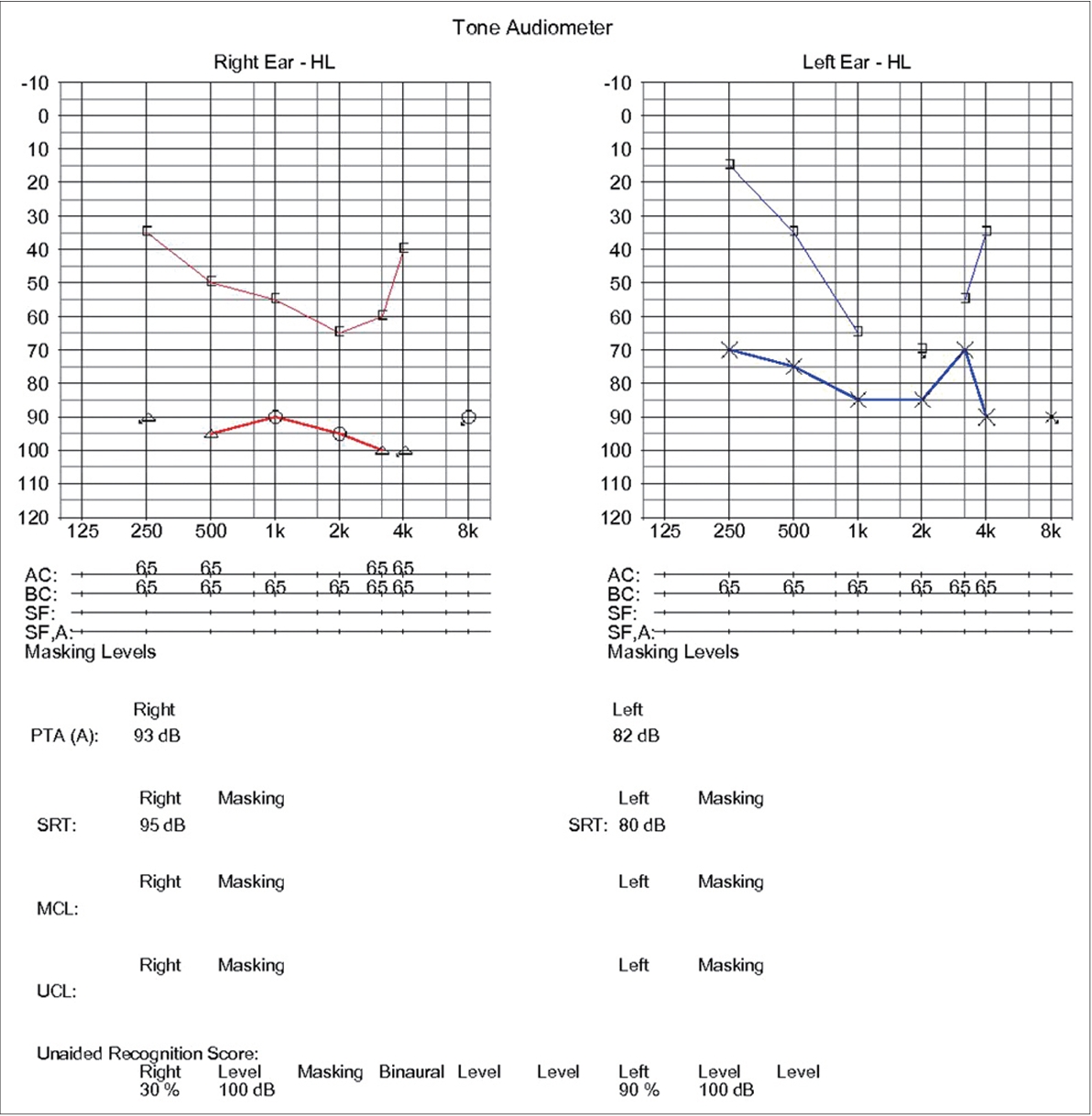
Fig.┬Ā2.Clinical photo. A: Branchial cleft fistulas were observed bilaterally at level 2 of the neck (white arrows). B and C: Bilateral preauricular fistulas were observed in the patient (black arrowheads). D and E: Constricted ear, which is helical cartilage deformity confined to the upper third of auricle (black asterisks). 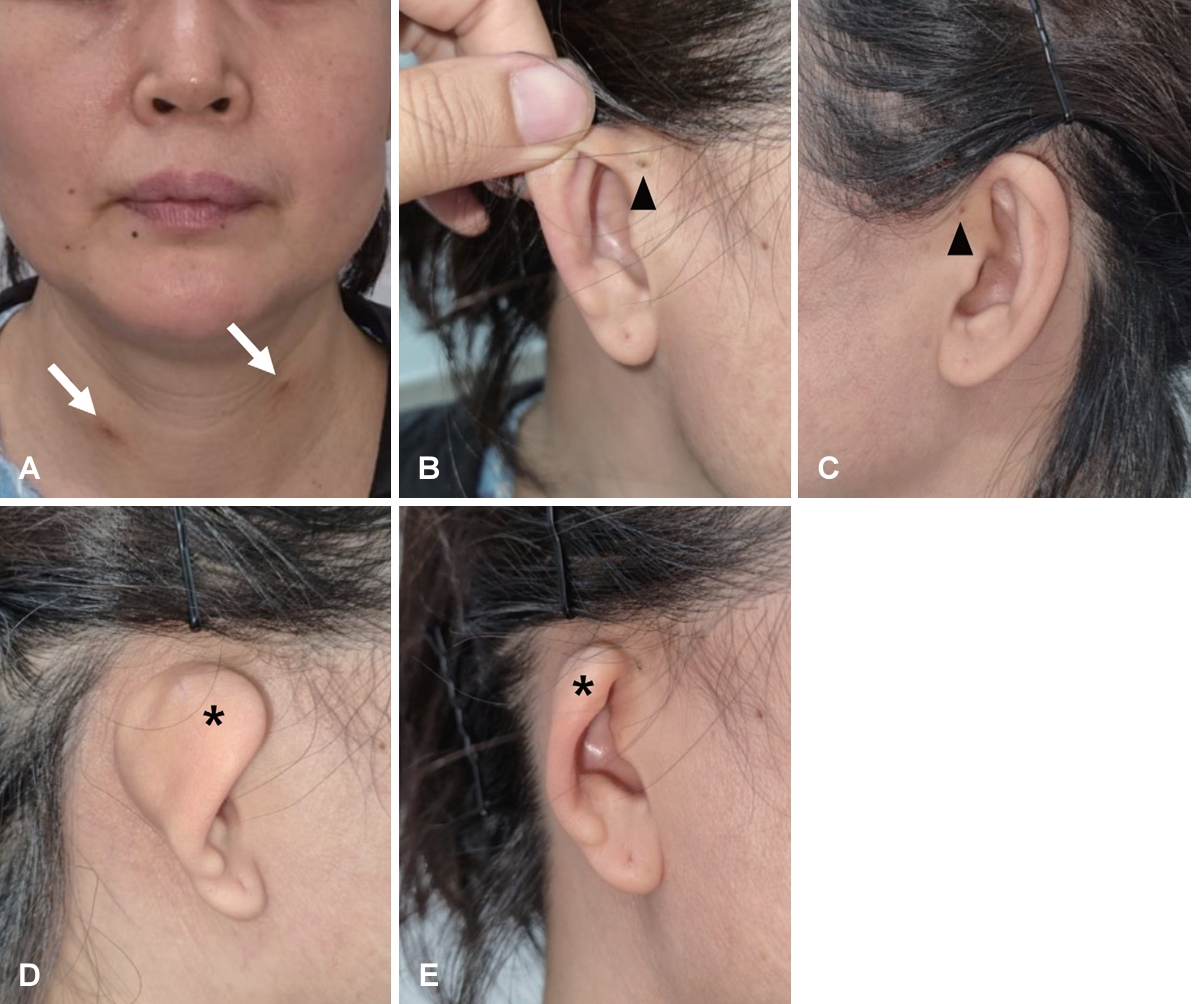
Fig.┬Ā3.This family tree shows the patientŌĆÖs family. The first daughter had no hearing impairment but had undergone surgery for bilateral type II branchial cleft fistulas and right preauricular fistula. The son had bilateral otitis media treated in the past and a congenital left stapes fixation, for which undergone stapedectomy. *the patient of this case report. 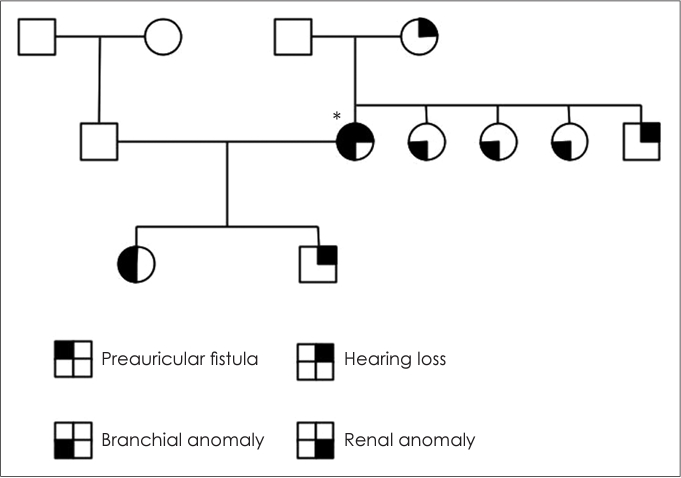
Fig.┬Ā4.Temporal bone and abdominal CT findings. A: Abdominal CT scan revealed normal findings in both kidneys. B: Left vestibular deformity seen on temporal bone CT (red arrow). C and D: Incomplete rotation of both cochlear seen on temporal bone CT (black arrowhead). 
Fig.┬Ā5.Surgical photographs. A: Left second branchial cleft fistula. B: Right second branchial cleft fistula. C: Post-surgery photo for surgical record. 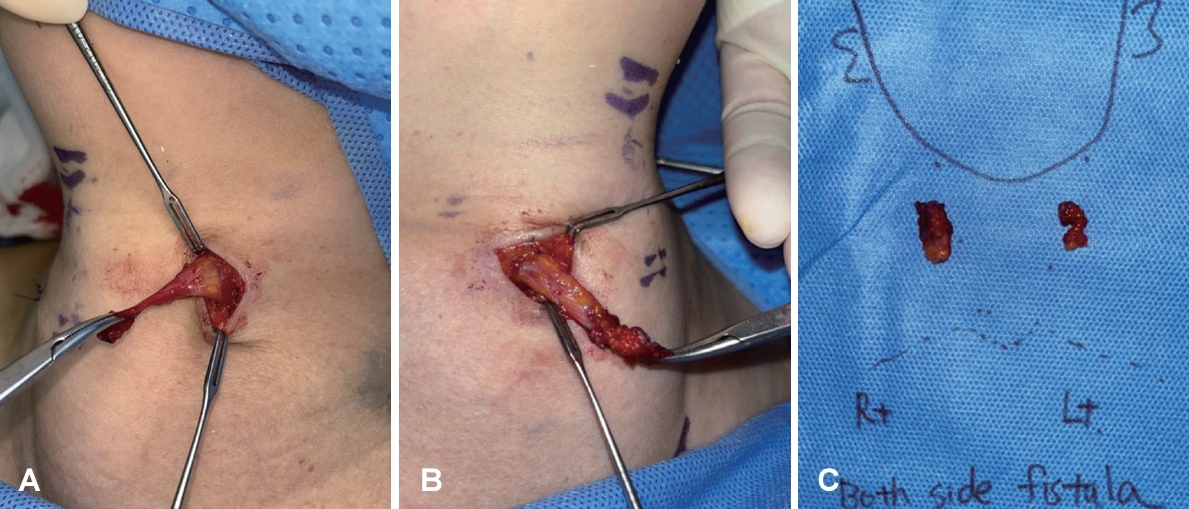
Fig.┬Ā6.Surgical photographs. A: Incision along the elliptical posterior extension line from the buried helix of the right upper ear. B: Completed preauricular fistulectomy state (arrowheads) and V-Y swing flap site for rotating the flap forward (asterisk). C: After aligning the boundary with suturing the flap at lateral view. D: Completed V-Y swing flap at posterior view. 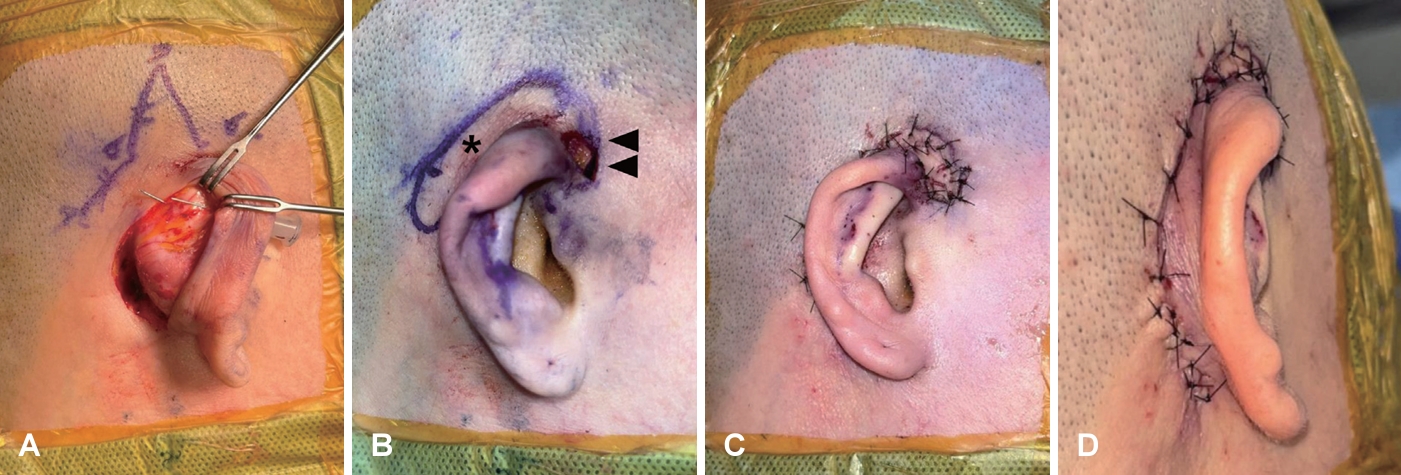
Table┬Ā1.List of case reports of branchio-otic syndrome reported in Korea
REFERENCES1. Fraser FC, Sproule JR, Halal F. Frequency of the branchio-otorenal (BOR) syndrome in children with profound hearing loss. Am J Med Genet 1980;7(3):341-9.
2. Morisada N, Nozu K, Iijima K. Branchio-oto-renal syndrome: comprehensive review based on nationwide surveillance in Japan. Pediatr Int 2014;56(3):309-14.
3. Vincent C, Kalatzis V, Abdelhak S, Chaib H, Compain S, Helias J, et al. BOR and BO syndromes are allelic defects of EYA1. Eur J Hum Genet 1997;5(4):242-6.
4. Krug P, Morini├©re V, Marlin S, Koubi V, Gabriel HD, Colin E, et al. Mutation screening of the EYA1, SIX1, and SIX5 genes in a large cohort of patients harboring branchio-oto-renal syndrome calls into question the pathogenic role of SIX5 mutations. Hum Mutat 2011;32(2):183-90.
5. Propst EJ, Blaser S, Gordon KA, Harrison RV, Papsin BC. Temporal bone findings on computed tomography imaging in branchio-otorenal syndrome. Laryngoscope 2005;115(10):1855-62.
6. Kemperman MH, Stinckens C, Kumar S, Huygen PL, Joosten FB, Cremers CW. Progressive fluctuant hearing loss, enlarged vestibular aqueduct, and cochlear hypoplasia in branchio-oto-renal syndrome. Otol Neurotol 2001;22(5):637-43.
8. Cho YS, Byun HY. Surgery for minor auricle deformity. J Clin Otolaryngol Head Neck Surg 2012;23(2):171-84.
9. Chang EH, Menezes M, Meyer NC, Cucci RA, Vervoort VS, Schwartz CE, et al. Branchio-oto-renal syndrome: the mutation spectrum in EYA1 and its phenotypic consequences. Hum Mutat 2004;23(6):582-9.
10. Kim SK, Kim YG, Ham SC, Oh SW, Park YW, Kim SW. A case of branchio-oto-renal syndrome. J Korean Pediatr Soc 2000;43(7):983-7.
11. Kim HJ, Yoon YH, Joo JY, Yoon YH. A case of branchio-oto-renal syndrome. Korean J Otorhinolaryngol-Head Neck Surg 2011;54(11):784-7.
12. Hong JJ, Shin YS, Kim YT, Kim CH. A case of branchio-otic syndrome. Korean J Head Neck Oncol 2011;27(1):84-7.
13. Kim TY, Eom JW, Kwak HH, Heo KW. A case of branchio-otic syndrome. Korean J Otorhinolaryngol-Head Neck Surg 2011;54(7):493-6.
|
|
|||||||||||||||||||||||||||||||||||||||||||||||||||||||||||||||||||||||||||||||

 |
 |